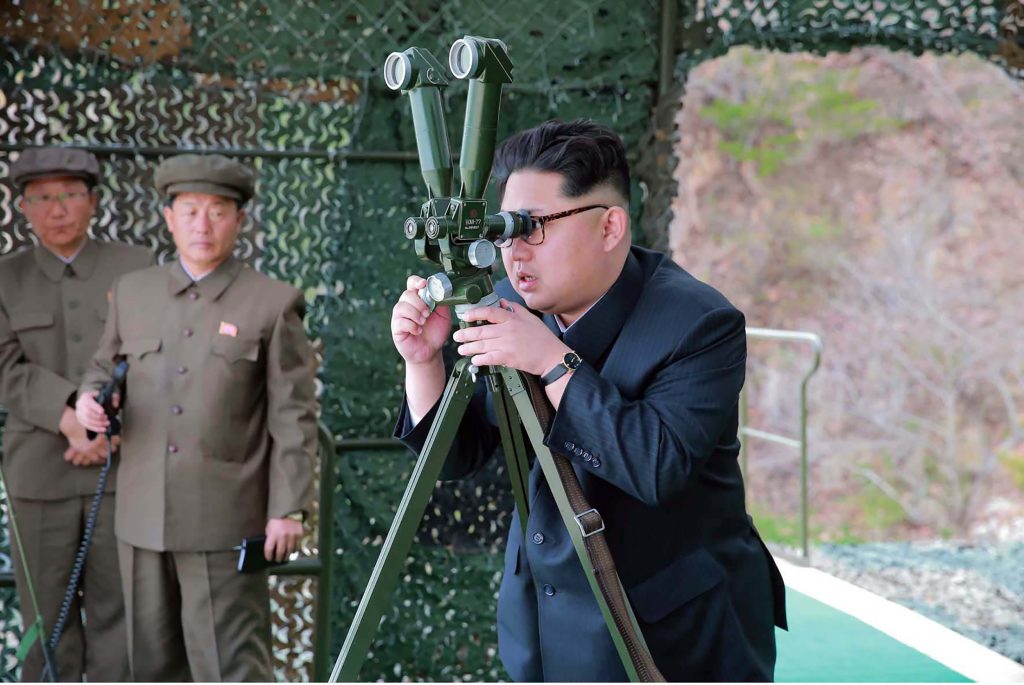
North Korean leader Kim Jong-Un hailed a submarine-launched ballistic missile (SLBM) test as an “eye-opening success”, state media said on April 24, declaring Pyongyang has the ability to strike Seoul and the US whenever it pleases.
by Jung Ha-Won
SEOUL , South Korea (AFP) — North Korea on Thursday tried and failed in what appeared to be its second attempt in two weeks to test a powerful, new medium-range ballistic missile, South Korea’s defence ministry said.
A ministry official said the North had fired what was believed to be a Musudan missile at around 6:40 am (2140 GMT Wednesday) from Wonsan on the east coast, but it plunged back to earth seconds after launch.
“It is believed to have failed,” the official told AFP.
There had been widespread intelligence reports in recent days that the North was preparing for another flight test of a Musudan, which is capable of striking US bases on the Pacific island of Guam.
North Korea initially launched a Musudan on April 15 — the birthday of founding leader Kim Il-Sung — but the exercise ended in what the Pentagon described as “fiery, catastrophic” failure, with the missile apparently exploding just after take-off.
Landmark congress
The failed tests come as the country is gearing up for a rare and much-hyped ruling party congress next month, at which Kim Jong-Un is expected to take credit for pushing the country’s nuclear weapons programme to new heights.
There is growing concern that Pyongyang is preparing to conduct a fifth nuclear test in the run-up to the event which opens May 6.
In recent months the North has claimed a series of major technical breakthroughs in developing what it sees as the ultimate goal of its nuclear weapons programme — an intercontinental ballistic missile capable of delivering a nuclear warhead to targets across the continental United States.
The achievements trumpeted by Pyongyang have included miniaturising a nuclear warhead to fit on a missile, developing a warhead that can withstand atmospheric re-entry and building a solid-fuel missile engine.
Last Saturday, it successfully tested a submarine-launched ballistic missile (SLBM) and was promptly criticised by the UN Security Council.
Existing UN resolutions forbid North Korea from the use of any ballistic missile-related technology.
Longer range
The Musudan is believed to have an estimated range of anywhere between 2,500 and 4,000 kilometres (1,550 to 2,500 miles). The lower range covers the whole of South Korea and Japan, while the upper range would include US military bases on Guam.
The missile has never been successfully flight-tested.
Two failures in swift succession will be seen as an embarrassment for the leadership, especially ahead of the party congress which is meant to celebrate the country’s achievements.
Speaking last weekend during a visit to Germany, US President Barack Obama warned that North Korea was making dangerous progress even when its efforts fell short of outright success.
“Although, more often than not, they fail in many of these tests, they gain knowledge each time,” Obama said.
“We take it very seriously, so do our allies and so does the entire world,” he added.
Anxiety has been high on the divided Korean peninsula since Pyongyang conducted its fourth nuclear test in January and a rocket launch a month later that was widely seen as a disguised ballistic missile test.
The UN Security Council responded with its toughest sanctions to date, angering the North, which has since made repeated threats of attacks targeting the South and the United States.
© 1994-2016 Agence France-Presse








